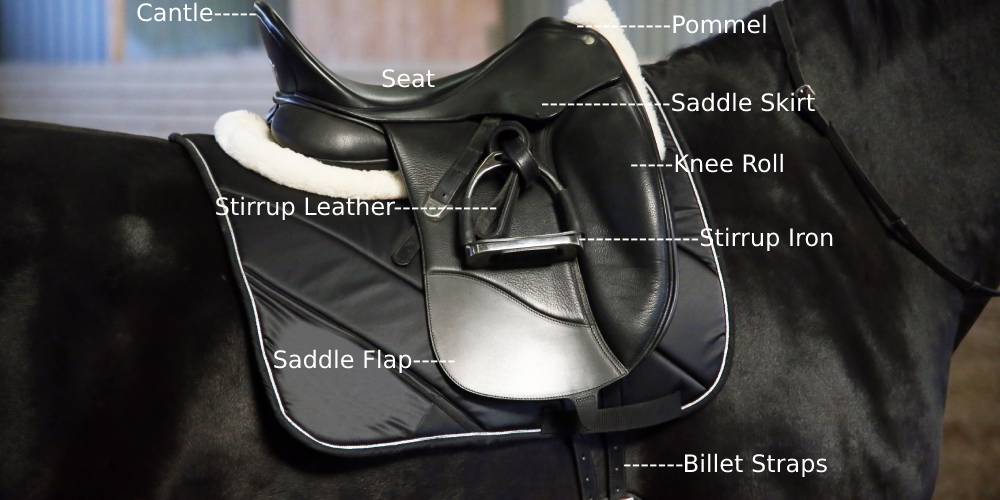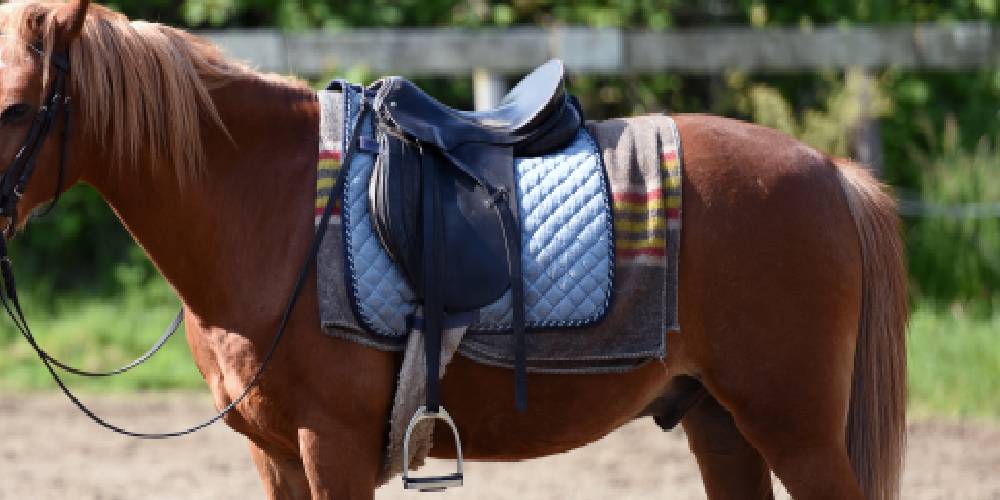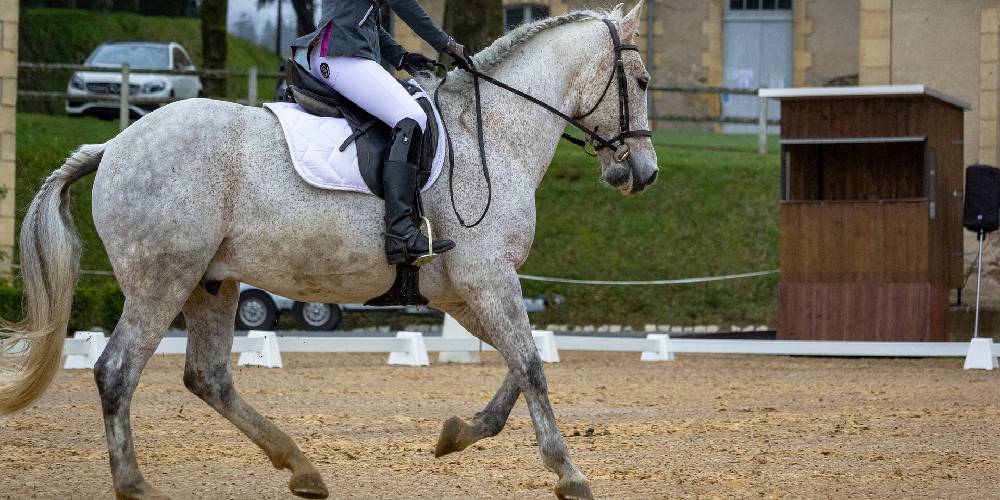The Dressage saddle is a unique piece of tack that, to riders of other disciplines, may look quite strange. The long flaps, the strange girth attachments, the deep seat, the large knee rolls; it’s enough to make someone who rides in a hunter saddle or jumping saddle take another look. Because some of you reading this may not know what a dressage saddle is or what the difference is between a dressage saddle and other saddles, I am here to help break it down and teach you the difference!
What Is A Dressage Saddle?
A dressage saddle is a type of saddle found in the English style of riding. These saddles are seen being used only in dressage and general riding. These saddles can be identified by their taller appearance and unique girth attachment system. Dressage saddles have a taller pommel and cantle than other English saddles to help hold the rider upright and in place. Dressage requires riders to sit many of the horse’s gaits which is why the saddle is made with a deeper seat as it helps to secure the rider.
What Do Dressage Saddles Look Like?

Dressage saddles have a very distinct appearance that makes them stand out from all other saddles. Every part of the dressage saddle is different from the parts of any other English saddle. The parts and general description of the dressage saddle are:
General Description Of The Dressage Saddle
The Dressage saddle is a saddle that has a very deep seat, large long knee rolls, a high pommel and cantle, and a unique girth attachment system. The dressage saddle has these features to help hold the rider in place as they ride their horse around the dressage arena.
The Pommel
As I have already said before, the dressage saddle has a high pommel. The pommel, for those of you who don’t know what it is, is the raised rounded part at the front of the saddle. In dressage saddles, the pommel is higher to help keep the rider back in their seat.
The Cantle
The Cantle of the saddle is the part that lies directly behind the seat of the saddle. Think of this part of the saddle as a miniature backrest on the saddle. In dressage saddles, the cantle is noticeably higher than what is seen in other English saddles. This is because, like the pommel, this part of the saddle is designed to keep the rider center and stable.
The Seat
I personally love a saddle that has a deep seat just because I feel so much more secure. Dressage saddles not only have a naturally deep seat but the high pommel and cantle on this saddle make the seat even deeper.
The Flap
You may notice that the dressage saddle almost appears to look long or tall. The flaps of the saddle, the part where you would rest your legs against, are noticeably elongated in shape. I believe that the reason for this design is because you hold your legs so much lower and extended in dressage than in any other English discipline so the long flap is making up for the additional length you have in your stirrups.
The Stirrup
The stirrups on a dressage saddle are pretty much like the stirrups you might find on a jumping saddle or flat saddle. The only difference is that these stirrups are a little bit taller and are slightly wider than other English stirrups. Though any English stirrup woll work in a dressage saddle, stirrups specifically for dressage are sold.
The Stirrup Leathers
In dressage, the rider rides their horse with their legs straight under them and slightly extended. Because of this extension of the legs, the stirrup leathers need to be longer than what is seen in other riding disciplines.
To show the difference, the average set of stirrup leathers used for jumping measures out at 54 inches (137 centimeters) while the average set of stirrup leathers used for dressage measures out at about 60 inches (152 centimeters). With this in mind, you can see how much longer the stirrup leathers themselves are and see how much longer they need to be for this discipline.
The Billet Straps
In the saddles used by other English riding disciplines, the billet straps are only visible if you lift up the saddle flap. This is another place where the dressage saddle is unique. Unlike most other saddles, the billet straps are actually long enough to extend below the saddle flap.
The Stirrup Bar
The stirrup bar is a part of the dressage saddle that is seen on all other saddles. It is to this part that the stirrup leathers attach to the saddle. The stirrup bar is a part of the dressage saddle that is only visible of you lift up the saddle skirt. The stirrup bar is like a flat curved piece of metal that the stirrup leathers go over. Without the stirrup bar, there would be no place to attach stirrups to the saddle.
The Skirt
The skirt of a saddle is just that small, curved leather flap that appears just above the stirrup leathers. It is under this that the stirrup bar is located and the stirrup leathers attach. The purpose of the skirt on the dressage saddle is just to cover the stirrup bars and the adjustment buckles found on the stirrup leathers themselves. In dressage saddles, the skirt of the saddle may be curved down lower than in other English saddles just so it can match the other elongated parts of the saddle.
The Knee Rolls
One of the easiest ways to tell if an English saddle is a dressage saddle or not is by looking at the knee rolls. On a dressage saddle, the knee rolls are large and long and extend almost the entire length of the saddle flaps. The knee rolls on these saddles are often solid or hard to the touch rather than soft or squishy like the knee rolls on a jumping or all purpose saddle. Sometimes, the knee rolls on the dressage saddle aren’t like standard knee rolls seen on saddles and instead are almost like blocks as they pretty much are just blocks added where a knee roll would be which forces your leg into proper position.
How Big Are Dressage Saddles?

Because dressage saddles are longer than other saddles to make up for the rider’s extra leg extension, they are technically a little bit bigger than other English saddles.
It is hard to say about how big these saddles are because all dressage saddles come in different shapes, sizes, and designs.
To get an idea of how much bigger or heavier these saddles are compared to a jumping saddle, you can look at how much each saddle weighs. The average dressage saddle weighs between 15 and 25 pounds while the average jumping saddle weighs between 10 and 15 pounds.
What Colors Do Dressage Saddles Come In?
Dressage saddles, like most other saddles, can come in a number of colors. The colors that they can come in include:
- Black (the most common color)
- Tan
- Brown
- Two-toned (the saddle is made of two different colored materials)
Are Dressage Saddles Expensive?

Dressage saddles are one of the most expensive types of English saddles on the market. The average price for a new dressage saddle (in US dollars) falls between $4,000 and $8,000 depending on the brand, the maker, the size, the style, and the design. If you aren’t really wanting to spend so much on a saddle, you can easily find used dressage saddles anywhere from $500 to $4,000.
Where Can I Buy A Dressage Saddle?
Dressage saddles can be bought almost anywhere that English saddles are sold. You can find these saddles sold:
- Online
- At Tack Consignment Stores
- At Horse Show Booths
- At Tack Shops

